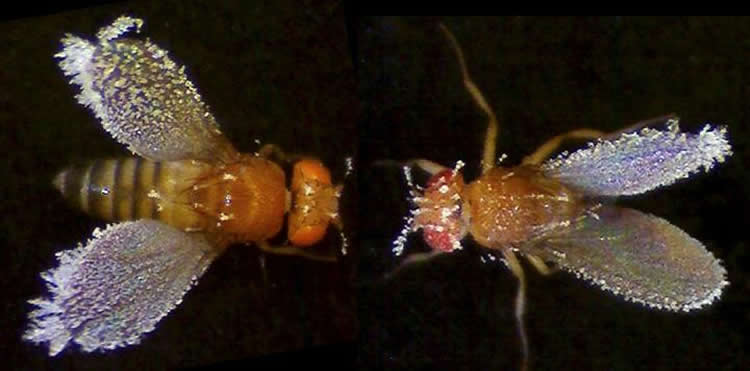Summary: A new study using fruit fly models could help researchers better understand the genetic and neural bases of detecting cold or painful stimuli.
Source: Georgia State University.
The tiny fruit fly can help humans investigate the genetic and neural bases of detecting painful or harmful cold stimuli and offer intriguing, potential implications for human health, according to a new study.
A team of researchers led by Dr. Daniel N. Cox, associate professor of neuroscience at Georgia State University, has discovered that fruit flies have cold-sensing neurons that when activated drive specific, aversive behaviors to damaging cold, which requires the function of evolutionarily conserved ion channels known as Transient Receptor Potential (TRP) channels.
In the journal Current Biology, the researchers establish the fruit fly, Drosophila melanogaster, as a powerful genetic and behavioral model for unraveling questions about the cellular and molecular bases of damaging cold perception, which have not been well understood.
The study explores the concept of nociception, the peripheral and central nervous systems’ perception of painful or potentially tissue damaging stimuli, which is generated by activating sensory nerve cells called nociceptors. This evolutionarily conserved process is critically important for survival.
Nociception, coupled with pain sensation, alerts an organism to possible environmental dangers and allows it to execute behavioral responses to protect against incipient damage. Acute and chronic pain can manifest as altered nociception in neuropathic pain states.
The study found that one of the implicated TRP channel genes called Pkd2 has been causally linked to autosomal dominant polycystic kidney disease (PKD), the most common monogenic disease in humans. Pkd2 ion channels appear to function as cold sensors and misexpression of Pkd2 can confer cold sensitivity to normally insensitive neurons. While it is not yet known if PKD patients have cold nociception defects, these new findings suggest this merits further investigation as a potential non-invasive diagnostic.
These same cold-sensing neurons also function as mechanosensors for touch, revealing that they, as well as the TRP channels identified in this study, are multimodal and raising the question of how neurons and ion channels distinguish between harmless and harmful stimuli to drive specific behavioral responses. Using sophisticated optical assays of neural activation by touch versus cold stimuli, the researchers demonstrate that these sensory neurons have different activation thresholds, with touch having a low threshold and cold having a high threshold, that ultimately determine the appropriate behavioral response.

“This new model sets the stage for uncovering evolutionarily conserved molecular control of nociception,” said Cox. “It also provides a powerful genetic platform for unraveling the neural circuitry and molecular mechanisms that integrate multimodal sensory input to produce specific behaviors in response to diverse environmental stimuli.”
The research team included Kevin Armengol, Atit A. Patel, Nathaniel J. Himmel, Luis Sullivan, Dr. Srividya C. Iyer and Dr. Eswar P.R. Iyer of the Cox Lab at Georgia State’s Neuroscience Institute and Center for Behavioral Neuroscience, and collaborators Heather N. Turner and Michael J. Galko from MD Anderson Cancer Center.
The next steps will be to dissect the neural circuitry, additional molecular players and synaptic mechanisms that modulate cold nociception and multimodal sensory processing.
Funding: The study was supported by the National Institutes of Health, Georgia State University.
Source: Natasha De Veauuse Brown, MPH – Georgia State University
Image Source: This NeuroscienceNews.com image is credited to Atit A. Patel and Daniel N. Cox of Georgia State University.
Original Research: Abstract for “The TRP Channels Pkd2, NompC, and Trpm Act in Cold-Sensing Neurons to Mediate Unique Aversive Behaviors to Noxious Cold in Drosophila” by Heather N. Turner, Kevin Armengol, Atit A. Patel, Nathaniel J. Himmel, Luis Sullivan, Srividya Chandramouli Iyer, Surajit Bhattacharya, Eswar Prasad R. Iyer, Christian Landry, Michael J. Galko, and Daniel N. Cox in Current Biology. Published online November 3 2016 doi:10.1016/j.cub.2016.09.038
[cbtabs][cbtab title=”MLA”]Georgia State University. “New Theory Debunks Idea That Math Abilities Are Inate.” NeuroscienceNews. NeuroscienceNews, 10 November 2016.
<https://neurosciencenews.com/cold-stimuli-neuroscience-5475/>.[/cbtab][cbtab title=”APA”]Georgia State University. (2016, November 10). New Theory Debunks Idea That Math Abilities Are Inate. NeuroscienceNews. Retrieved November 10, 2016 from https://neurosciencenews.com/cold-stimuli-neuroscience-5475/[/cbtab][cbtab title=”Chicago”]Georgia State University. “New Theory Debunks Idea That Math Abilities Are Inate.” https://neurosciencenews.com/cold-stimuli-neuroscience-5475/ (accessed November 10, 2016).[/cbtab][/cbtabs]
Abstract
The TRP Channels Pkd2, NompC, and Trpm Act in Cold-Sensing Neurons to Mediate Unique Aversive Behaviors to Noxious Cold in Drosophila
Highlights
•Drosophila assays for cold nociception reveal unique cold-evoked behaviors
•Class III md neurons are cold responsive and mediate cold-evoked behavior
•Pkd2, NompC, and Trpm are required in class III md neurons for cold nociception
•Class-III-mediated multimodal behavioral output depends on activation levels
Summary
The basic mechanisms underlying noxious cold perception are not well understood. We developed Drosophila assays for noxious cold responses. Larvae respond to near-freezing temperatures via a mutually exclusive set of singular behaviors–in particular, a full-body contraction (CT). Class III (CIII) multidendritic sensory neurons are specifically activated by cold and optogenetic activation of these neurons elicits CT. Blocking synaptic transmission in CIII neurons inhibits CT. Genetically, the transient receptor potential (TRP) channels Trpm, NompC, and Polycystic kidney disease 2 (Pkd2) are expressed in CIII neurons, where each is required for CT. Misexpression of Pkd2 is sufficient to confer cold responsiveness. The optogenetic activation level of multimodal CIII neurons determines behavioral output, and visualization of neuronal activity supports this conclusion. Coactivation of cold- and heat-responsive sensory neurons suggests that the cold-evoked response circuitry is dominant. Our Drosophila model will enable a sophisticated molecular genetic dissection of cold nociceptive genes and circuits.
“The TRP Channels Pkd2, NompC, and Trpm Act in Cold-Sensing Neurons to Mediate Unique Aversive Behaviors to Noxious Cold in Drosophila” by Heather N. Turner, Kevin Armengol, Atit A. Patel, Nathaniel J. Himmel, Luis Sullivan, Srividya Chandramouli Iyer, Surajit Bhattacharya, Eswar Prasad R. Iyer, Christian Landry, Michael J. Galko, and Daniel N. Cox in Current Biology. Published online November 3 2016 doi:10.1016/j.cub.2016.09.038






